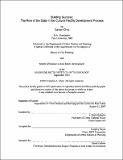| dc.contributor.advisor | J. Mark Schuster. | en_US |
| dc.contributor.author | Choy, Carolyn (Carolyn Anne) | en_US |
| dc.contributor.other | Massachusetts Institute of Technology. Dept. of Urban Studies and Planning. | en_US |
| dc.date.accessioned | 2008-09-03T14:37:27Z | |
| dc.date.available | 2008-09-03T14:37:27Z | |
| dc.date.copyright | 2007 | en_US |
| dc.date.issued | 2007 | en_US |
| dc.identifier.uri | http://hdl.handle.net/1721.1/42109 | |
| dc.description | Thesis (M.C.P. and S.M.)--Massachusetts Institute of Technology, Dept. of Urban Studies and Planning, 2007. | en_US |
| dc.description | Includes bibliographical references (p. 92-95). | en_US |
| dc.description.abstract | This thesis investigates the question of what is the current role of the state in the cultural facility development process, and, in light of facility-related warnings that have been made over the years, what role should the state take? I study if and how the states have responded to calls for change in the industry and also address the feasibility of a state-level cultural facilities funding program that successfully delivers both financial and technical assistance services to the arts and cultural sector. I use a mixed-method case study approach: a nationwide survey of state arts agencies, program guideline analysis, and interviews, culminating in case studies of selected state-level cultural facilities funding program. I find that the state currently plays a variety of roles in the cultural facility development process, due to a number of different factors in program design, such as program size and key decision-making entities, that affect a state agency's ability to act in an effective manner. There are two parts to program effectiveness-is it getting done? And, is it getting done well?-that are attributable to adequate funding and good discretionary judgment, respectively. Unfortunately, I find an inverse relationship between these two factors, which makes program effectiveness a challenge. Given this relationship, state agencies are forced to compensate for the sacrifice of one feature for the other, to varying degrees of success. I recommend that the state agencies ultimately embrace a process in which all discretionary powers are given up in the exchange for robust annual program funding that also includes substantial oversight responsibilities. In this way, programs are able to guarantee their viability and impact through the use of a long term framework for analysis. | en_US |
| dc.description.statementofresponsibility | by Carolyn Choy. | en_US |
| dc.format.extent | 95 p. | en_US |
| dc.language.iso | eng | en_US |
| dc.publisher | Massachusetts Institute of Technology | en_US |
| dc.rights | M.I.T. theses are protected by
copyright. They may be viewed from this source for any purpose, but
reproduction or distribution in any format is prohibited without written
permission. See provided URL for inquiries about permission. | en_US |
| dc.rights.uri | http://dspace.mit.edu/handle/1721.1/7582 | en_US |
| dc.subject | Urban Studies and Planning. | en_US |
| dc.title | Building success : the role of the state in the cultural facility development process | en_US |
| dc.title.alternative | Role of the state in the cultural facility development process | en_US |
| dc.type | Thesis | en_US |
| dc.description.degree | M.C.P.and S.M. | en_US |
| dc.contributor.department | Massachusetts Institute of Technology. Department of Urban Studies and Planning | |
| dc.identifier.oclc | 226315298 | en_US |
